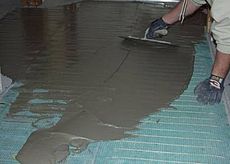Radiant heating - Simple English Wikipedia, the free encyclopedia
Radiant heating occurs when a hot surface warms other objects around it. Radiant heating has a long history of use in buildings by the Romans and the Koreans, and is much more efficient than standard ways of heating the air in a building. Underfloor radiant heating is the most common type of radiant heating used in buildings, but wall and overhead radiant heating systems are also used. Radiant heating can also be used to heat outdoor areas.
History of Radiant Heating
[change | change source]
The Romans were the first people to use underfloor radiant heating systems. These systems were based on hypocausts, and used warm air for heat. The floor was set on top of many brick piles, leaving room for the hot air and steam produced by a furnace to pass underneath the floor. The hot air then went up chimneys on the sides of the walls, so the hot air and steam never actually went into the living rooms. These systems were very expensive to build and maintain, so only the rich could afford them.[source?]
In Korea, radiant underfloor heating has been in use for about 2000 years. Ondol, which means "warm stone," involves the use of stones and underground ducts to help transport warm air from the kitchen to the rooms in the house. Most homes and buildings in Korea still use ondol, although they now use hot water and electric systems. The American architect Frank Lloyd Wright discovered ondol in the early 1900s and used it in many of his building designs. Wright also invented hot water underfloor systems.[1]
Types of Radiant Heating
[change | change source]Underfloor heating
[change | change source]The most common kind of radiant heating is underfloor heating. There are three types of underfloor heating: hot air systems, hot water systems and electric systems.
Hot air systems
[change | change source]Hot air systems use hot air to heat the floor, similar to the Romans' systems. However, air does not hold heat very well, and these systems aren't recommended for residential use. [2]
Hot water systems
[change | change source]Hot water systems are the most popular and cost-effective systems for cold climates. In this type of system, water is heated by a boiler and pumped through pipes laid underneath the floor. Hot water systems can also be combined with solar thermal energy to make them more environmentally friendly. Solar thermal energy uses sunlight to heat water, which can then be used in the underfloor heating system.
Hot water systems can also be run in reverse by running cold water through the pipes to cool the building. However, this technology is difficult to use properly and can result in condensation on the floor, which can ruin hardwood floors or rugs and make people more likely to fall.
Electric systems
[change | change source]Electric systems are made of electric cables that are laid underneath the floor. Electricity is then used to heat the cables, and this type of system can be turned on or off much faster than a hot water system. However, these systems are often more expensive than hot water systems because of the high prices of electricity, especially if the hot water system includes the use of solar thermal energy. The high cost of an electric heating system can be reduced if the floor can be set to heat during non-peak hours, such as late at night, and is left turned off during the day. Electric systems are also less environmentally friendly because electricity is usually produced by burning fossil fuels, which increases carbon emissions.
Underfloor installation
[change | change source]
Underfloor radiant heating systems can be installed as either wet or dry systems. Wet systems are laid down and then concrete is poured over them. Concrete floors hold heat very well, but can take a long time to absorb the heat. Dry systems run in open air space between the foundation and the floor, but can be less efficient because they have to heat the air too. However, dry systems are much easier to reach if the system breaks or leaks.
Any kind of flooring can be used with underfloor heating, but ceramic tiles are the most popular floor material because they transfer and store heat well. Materials like wood, carpet, or linoleum tile decrease the heat transfer from the underfloor system and the system must be set at a higher temperature if any of these materials are used.
Wall and overhead heating
[change | change source]Wall and overhead radiant heating systems are usually made of aluminum panels hung on the walls or ceiling. Like underfloor radiant heating, these panels can be heated by either hot water or electricity. However, panels heated by hot water often leak, so electric panels are the most common. These panels can't heat as much area as an underfloor system, but they can be quickly turned on and off when a person enters or leaves the room. Electric panels can reduce energy costs if panels are left turned off in empty rooms.[3]
Outdoor heating
[change | change source]Using radiant heating outdoors is much more practical than heating air because the air is always moving outside. Outdoor radiant heaters are almost always electric devices, and usually portable, although it is possible to have underfloor radiant heating installed under a patio.
Related pages
[change | change source]References
[change | change source]- ↑ "Ducted Heating". www.snowman.com.au. Archived from the original on 5 May 2016. Retrieved 23 April 2016.
- ↑ "Energy Savers: Ventilation Preheating". Archived from the original on 2012-08-14. Retrieved 2009-06-02.
- ↑ "Energy Savers: Radiant Heating". Archived from the original on 2012-08-14. Retrieved 2009-06-02.


 French
French Deutsch
Deutsch